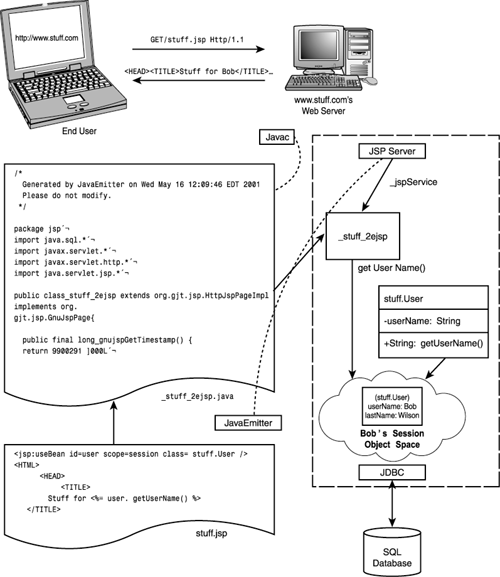So What Is JSP All About?
| I l @ ve RuBoard |
| If you meet the requirements mentioned, you should already have a pretty good idea what the answer to this question is. JSP is all about doing highly object-oriented Web sites that can leverage all the best practices of modern software engineering. These practices include things such as SQL databases and UML-based design. This isn't to say that JSP is a cure-all and that using it will automatically make your Web site a paragon of engineering art. It's just as possible to design bad Web sites in JSP as with any other technology. That's why, as you go through the text, you will see how to incorporate the best practices and how to avoid the pitfalls of convenience when projects get stressful. JSP itself is an evolutionary step along the path that started with the first static Web servers, moved through CGI-enabled servers, and finally the first generation of script-enabled servers. JSP is less a Web server with a Java component than it is a Java engine that understands the Web. JSP grew out of Java servlets. Servlets allow the developer to handle the incoming Web requests using a Java program that has access to all the normal information that a Common Gateway Interface (CGI) program would. In addition, the servlet has access to session-persistent objects. These are Java objects that are associated with a specific user session and can be used to store state between requests . Servlet programming was a major step forward in allowing developers to write well-structured modular Web applications using an object-oriented language. It also solved the problem of state persistence, allowing more information to reside on the server during a transaction and less to have to pass back and forth between the user and the server. Servlets still suffered from one major problem. Because they eventually need to spit out HTML, the HTML coding had to be embedded in the servlet code. This led to code fragments like the one shown here: // Output the HTML Header Out.println("<HTML>\n<HEAD>\n<TITLE>Thank you for Registering</TITLE></HEAD>\n"); Out.println("<IMG SRC=\"thanks.jpg\" WIDTH=200 HEIGHT=100 ALIGN=\"LEFT\">"); This kind of embedding gets very old very fast when you have to code a lot of pages. In addition, having to escape all of the quotation marks can lead to a lot of confusing and hard-to-find errors if you leave out a backslash. Eventually, a still-better idea emerged. Suppose that you could combine the best of static HTML pages and with the interactive capabilities of servlets. The result was JavaServer Pages (on the Microsoft side, the result was Active Server Pages). As Figure I.1 shows, JSP is a complicated beast . In the next chapter, you'll walk through this flow in detail, but for the moment, here are the major steps:
Figure I.1. Looking at the JSP processing flow. That is the way that JSP handles requests. As you can see, a tremendous amount of power is available in the JSP world. Developers are free to write Web pages that look mostly like HTML, except where callouts to Java are required. But, at the same time, they are free to develop fully fleshed-out object-oriented applications using all the features that Java can bring to bear. They also get all the benefits of servlets, including session persistence.
|
| I l @ ve RuBoard |
EAN: 2147483647
Pages: 203
